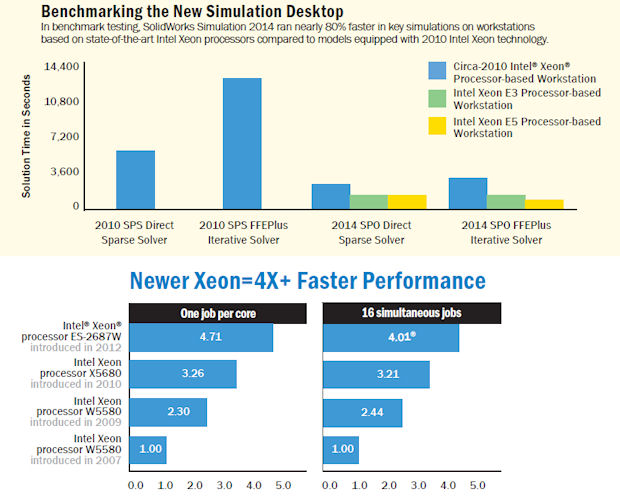The Smart Money Is on a Workstation Refresh
Latest News
July 1, 2014
 With the rapid-fire pace of technology change today, working on a three-year-old workstation is akin to driving a decade-plus clunker—it gets you to your destination, but likely with some major hiccups along the way.
With the rapid-fire pace of technology change today, working on a three-year-old workstation is akin to driving a decade-plus clunker—it gets you to your destination, but likely with some major hiccups along the way.
A three-year old workstation might be capable of running the latest versions of CAD or CAE software, but it’s hardly optimized to exploit the tools to their fullest capacity. In fact, an old workstation can be the bottleneck to modern, analysis-led engineering workflows. Older workstations are based on past-generation processor and bus technologies, which have since been updated with new instruction sets and micro architectures that streamline how data is handled. That means a three-year-old workstation based on a 3GHz processor is not the equivalent of a workstation built with a comparable 3GHz processor today.
High-performance workstations based on the latest Intel Xeon processor E5-2600 v2 product family can execute more instructions per second, allowing them to run CAE and CAD software faster. As a result, engineering teams outfitted with the latest workstation models are able to explore a greater number of design concepts up to three times faster and for less money. The ability to conduct more simulation studies means engineering teams can reduce the number of physical prototypes required while arriving at the optimal product design much more quickly.
Beyond the Need for Speed
There’s more to a workstation upgrade than building the case for a high-octane processor, however. Configuring a next-generation workstation today is all about balance, blending the right mix of processor, graphics cards, memory, and storage to create the best experience for CAD and simulation workflows. Workstations that are three years old or later won’t necessarily support the other modern-day components that work together to deliver productivity advances at less cost.
Consider this scenario: Buying one or two frequencies down from the premier CPU clock speed or opting for a less expensive graphics card can generate savings that can be redirected toward additional memory or SSD drives, which can have a greater overall impact on boosting productivity. For example, an investment in twice the memory capacity of the largest CAD model can deliver a performance increase of up to 2X on that model for less money than opting for a workstation based on the highest end CPU.Trading off graphics horsepower for additional SSD storage can deliver similar performance benefits, again at less expense. Entry-level GPUs are sufficient for most CAD users’ needs; in fact, informal testing by CATi, a SolidWorks reseller, found the performance difference between a $150 entry-level graphics card and $1,500 high-end model to be just 6% during the course of an average workday by a typical engineering user.
The Software Side of Performance
Also essential to a workstation refresh is running the latest versions of CAD or simulation software fully optimized to exploit the new hardware capabilities, from multiple cores to microarchitectures and faster bus technologies. Consider the example of SolidWorks Simulation 2014 running on an updated workstation with multiple cores. Based on testing by SolidWorks and Intel, multicore support delivered a 2X speed boost to FFEPlus operations. Moreover, because the Large Problem Direct Sparse Solver is much faster than the Direct Sparse Solver for problems with millions of degrees of freedoms (DOFs), solution time for a chassis simulation with 3,360,485 DOFs performed in minutes as opposed to hours.
Holding off an engineering workstation upgrade solely because of the expense of new hardware is short sighted and misguided in terms of total savings. The dollar value associated with the business advantages of effective simulation-based design workflows—specifically, greater exploration of more designs in much shorter timeframes—will universally outweigh any initial investment in new hardware.
 To configure your ideal workstation, go to www.intel.com/content/www/us/en/workstations/workstation-configurator-tool.html.
To configure your ideal workstation, go to www.intel.com/content/www/us/en/workstations/workstation-configurator-tool.html.
Subscribe to our FREE magazine, FREE email newsletters or both!
Latest News







